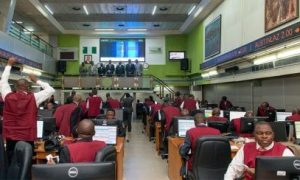…2025 Half Year Outlook
After a choppy 2024, the Nigerian economy is gradually finding its footing.
As we envisaged, economic activity has gained momentum, with the Composite Purchasing Manager Index (PMI) consistently settling above the fifty point threshold in H1-25, supported by moderating cost pressures, FX stability and a gradual improvement in business confidence.
Inflationary pressures in H1-25 were more broadly subdued, reflecting reduced exchange rate pass-through and relatively stable energy prices, even as the rebasing of the Consumer Price Index (CPI) in January led to a technical drop in the reported inflation rate.
The naira traded relatively stable, closing H1-25 stronger than anticipated, amid elevated global headwinds.
With the commencement of H2-25, we continue to adopt a cautiously optimistic stance. GDP growth is expected to remain robust as economic strains induced by the reforms continue to ease.
With domestic inflation expected to continue easing, the Monetary Policy Committee (MPC) may begin to consider a gradual pivot toward monetary easing. However, the relatively tight global financial environment and uncertainties stemming from global trade tension and geopolitical instability will likely constrain the depth of rate cuts, as the Bank seeks to maintain the naira’s attractiveness for carry trade inflows.
Twin Pressures
In addition, sizable external debt repayments in H2-25 may constrain the Bank’s capacity to maintain the level of FX intervention deployed earlier in the year. If global pressures persist, this could lead to a gradual depreciation of the naira toward NGN1,700.00/USD.
On the fiscal front, twin pressures, from subdued oil prices and below par production, raise the risk of a significant shortfall in oil revenue, potentially widening the fiscal deficit beyond our revised estimate of NGN16.49 trillion (Previous: NGN12.33 trillion projection).
Equities Market
The equities market delivered strong gains in H1-25, underpinned by resilient corporate earnings, easing inflation, and robust participation from domestic institutional investors.
Looking ahead, we expect selective upside in H2-25, buoyed by anticipated monetary easing, improving FX conditions, and sustained earnings momentum across key non-financial sectors.
Although a broad-based resurgence of foreign portfolio inflows is unlikely, improving macro conditions could attract cautious re-entry into high-quality, liquid names.
Our base-case forecast projects a +20.6% return on the NGX All-Share Index for 2025. In the fixed income space, yields declined sharply in H1-25, following a significant drop in inflation (aided by the CPI rebasing), which prompted markets to price in a pivot to monetary easing. Heading into H2-25, we expect continued volatility, with monetary policy decisions remaining the key driver.
As easing takes hold, we forecast yields to settle around 20.5% for Treasury bills and 17.0% for FGN bonds by year-end.
Cordros



























